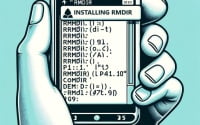406 Not Acceptable Error | HTTP 406 Status Code Explained

Have you ever been puzzled by a ‘406 Not Acceptable’ error while browsing the web? This error, though cryptic, is part of the HTTP status code family that servers use to communicate with web browsers. Imagine HTTP status codes as traffic signals, with each code representing a different type of signal. The ‘406 Not Acceptable’ error is like a red light, indicating a stop or a problem.
In this article, we’ll demystify the ‘406 Not Acceptable’ error, delve into its common causes, and provide a comprehensive guide to troubleshoot it. Whether the error is due to an incorrect URL input or a more complex issue, we’ve got you covered. So buckle up, as we’re about to embark on a journey into the intricate world of HTTP status codes, preventive measures, and troubleshooting techniques. By the end of this guide, you’ll be equipped to handle the ‘406 Not Acceptable’ error like a pro.
TL;DR: What is the ‘406 Not Acceptable’ error?
The ‘406 Not Acceptable’ error is an HTTP status code indicating that the server is unable to fulfill a request with an acceptable response format defined by client-provided accept headers. If the server replies anyway, the client is likely to reject the reply. This guide will help you navigate and solve such issues.
Table of Contents
Understanding the 406 Error
Let’s start by deciphering the ‘406 Not Acceptable’ error. Within the HTTP status code family, ‘406 Not Acceptable’ stands as a client error response. It signifies that the server is unable to deliver data in the format requested by the client or the web browser. This is where the interplay between status codes, the client (or web browser), web application, and web server comes into the picture.
Imagine it as a dialogue – the client sends a request to the server, the server responds, and the status codes form the language they use to communicate. When the server fails to fulfill a request, it sends an error code, in this case, a ‘406 Not Acceptable’.
Diagnosing these errors can be challenging because the problem could originate from anywhere in the communication chain – the client, the web application, or the server. A frequent trigger for a 406 error is the ‘Accept’ header, a tool the client uses to indicate to the server what media types it can comprehend. If the server can’t deliver the requested media type, it responds with a ‘406 Not Acceptable’.
The complexity escalates when third-party web services get involved. For instance, a user agent (like a web browser) might request a specific character set or language that the server can’t provide, leading to a 406 error. The more elements involved, the higher the potential for error. However, by the end of this guide, you’ll be adept at navigating these challenges.
Identifying the Source of the 406 Error
With a basic understanding of the ‘406 Not Acceptable’ error in place, it’s time to delve deeper and identify the source of the error. Is it on the server-side or the client-side? This distinction is vital, as the troubleshooting steps will vary based on the origin of the problem.
Server-side Issues
Often, the server can be the root cause of a 406 error. For instance, server misconfigurations or problematic traffic routing issues could result in a 406 error. But how can you identify if the server is the problem? A good starting point is to examine the server logs for any conspicuous errors or warnings.
Client-side Issues
On the other hand, the client-side code and components can also instigate a 406 error. For example, if a user inputs an incorrect URL, the server might respond with a 406 error because it can’t locate the requested resource. This highlights the importance of double-checking URLs for typos or incorrect paths.
Another potential client-side culprit is a misbehaving web app. If a web app is sending incorrect requests to the server, it could trigger a 406 error. Therefore, it’s crucial to monitor all the web apps running on your site, ensuring they’re up-to-date and correctly configured.
As evident, diagnosing a 406 error involves a bit of detective work. However, with a systematic approach and a keen eye for detail, you can pinpoint the source of the error and restore your site’s functionality.
Preemptive Measures: Starting with a Thorough Backup
Before we delve into the intricacies of troubleshooting a ‘406 Not Acceptable’ error, let’s discuss an indispensable step that should never be overlooked: creating a comprehensive backup. Imagine attempting to resolve an issue, only to inadvertently create a new one, with no means to revert the changes. It’s a daunting scenario, isn’t it? That’s where backups come into play.
The Importance of Backups
Creating a full backup of your site prior to troubleshooting guarantees you have a safety net to fall back on if something goes wrong. It’s akin to having a time machine that enables you to revert your site back to a state before the error occurred. This is not just a best practice for troubleshooting the 406 error, but for any kind of website maintenance or development work.
The Role of a Secondary Server
What if you wish to test potential fixes without affecting your live site? That’s where a secondary server becomes useful. By replicating your live environment on a secondary server, you can safely test fixes without the risk of disrupting your live site.
If you’re using cPanel, setting up a staging environment is straightforward with the Softaculous app installer. A staging environment is essentially a clone of your live site where you can test changes without impacting the live site. This allows you to troubleshoot and resolve errors like the 406 Not Acceptable error without any downtime.
Remember, a backup is not just about being able to restore your site in case of an error. It’s also about preserving the security and integrity of your live application. Without a backup, you run the risk of losing data, causing downtime, and potentially damaging your site’s reputation. So, before you commence troubleshooting a 406 error, ensure you have a thorough backup in place. You’ll thank yourself later.
Client-side Causes of 406 Not Acceptable
Having discussed the importance of backups and the distinction between server-side and client-side errors, let’s now explore some common client-side causes of the ‘406 Not Acceptable’ error.
Software Platforms
Popular software platforms like WordPress, Drupal, or Joomla, while powerful and versatile, can at times be the culprits behind a 406 error. For instance, a bug in the platform’s code or a conflict between different software pieces could be the trigger.
Recent Updates
Recent updates, despite their usual benefits of new features and security enhancements, can also lead to a 406 error. Sometimes, an update can inadvertently introduce a bug or a conflict, resulting in a 406 error.
New Plugins, Extensions, or Modules
The installation of new plugins, extensions, or modules can potentially lead to a 406 error. These additions, while enhancing the functionality of your website, can sometimes conflict with other software on your site or alter settings unexpectedly, triggering a 406 error.
Unexpected Database Changes
Unexpected database changes can pose a challenge. For instance, a plugin might modify a database record, leading to a 406 error. Other varied causes, like MIME type violations and incorrect compression methods, can trigger a client-side 406 error. MIME types are a way of telling browsers how to handle specific types of files. If a server sends a file with a MIME type that the client doesn’t understand, it can result in a 406 error.
In conclusion, while these software platforms, updates, and plugins enhance your website’s functionality and appearance, they can sometimes be the root cause of a 406 error. Therefore, it’s important to keep track of any changes you make to your site and to test new additions in a staging environment before implementing them on your live site.
Server-side Causes of 406 Error
Shifting our focus to the server-side, let’s discuss some potential causes of the ‘406 Not Acceptable’ error. Understanding these causes can aid in pinpointing the source of the error and guide your troubleshooting efforts.
Security Rules
Security rules are designed to shield your server and site from malicious activities. However, at times, they might be overly strict, blocking legitimate requests and leading to a 406 error. For instance, if a security rule is set to block requests from certain user agents or IP addresses, it might inadvertently block a legitimate user, triggering a 406 error.
Server Conditions
Specific conditions on your server can escalate the likelihood of encountering a 406 error. These conditions could include server misconfigurations, software bugs, or even network issues. If your server is grappling with the volume of requests it’s receiving, or if it’s having trouble communicating with other servers, it could respond with a 406 error.
Large Request or Response Bodies
Large request or response bodies can also instigate a 406 error. HTTP requests and responses consist of a header and a body. The header contains metadata about the request or response, while the body contains the actual data. If the body of a request or response is too large, the server might not be able to process it, leading to a 406 error.
Known Malware or Phishing Content
Known malware or phishing content on your server can trigger a 406 error. If your server detects suspicious activity, such as an attempt to upload malware or carry out a phishing attack, it might respond with a 406 error to safeguard your site.
In conclusion, a variety of server-side issues can trigger a 406 error. By understanding these potential causes, you can more effectively diagnose and resolve the error. Remember, systematic troubleshooting is key: identify the potential causes, test them one by one, and apply the necessary fixes.
Preventing 406 Error
Having explored both client-side and server-side causes of the ‘406 Not Acceptable’ error, it’s time to discuss how to prevent this error from occurring in the first place. As the saying goes, prevention is better than cure!
ModSecurity
One of the key players in preventing the 406 error is ‘mod_security’. ModSecurity is an open-source web application firewall that provides protection from a range of attacks against web applications. However, at times, mod_security can be overly protective and end up blocking legitimate requests, leading to a 406 error. In such instances, disabling mod_security can help prevent the error.
But be cautious, disabling mod_security can leave your site vulnerable to attacks. Also, enabling or disabling mod_security can be challenging, especially if you’re not familiar with server administration. If you’re unsure, it’s always best to contact technical support for assistance.
Website Management
Preventing the 406 error also involves diligent management of your website’s plugins, themes, and extensions. Regular database cleaning, site optimization, routine debugging of the server and web application, and setting automated backups for your website or application can also help prevent a 406 error.
If you’re using cPanel, you can disable ModSecurity for each domain individually. This allows you to fine-tune your security settings and reduce the likelihood of a 406 error.
Regular Maintenance
Lastly, don’t underestimate the power of regular maintenance. Minimizing plugins, frequent debugging, and regular backups can contribute significantly to keeping your site error-free. Remember, a well-maintained site is not just about preventing errors; it’s also about providing a smooth and enjoyable experience for your users.
Conclusion
And there we have it – a comprehensive guide to understanding, troubleshooting, and preventing the ‘406 Not Acceptable’ error. We’ve unraveled the mystery behind this elusive error, dove into the intricate world of HTTP status codes, and explored both client-side and server-side causes of the error.
We’ve emphasized the importance of backups and staging environments when troubleshooting, and shared insights on how to prevent the error by managing your website’s plugins, themes, and extensions, and by carefully configuring security rules.
While the ‘406 Not Acceptable’ error may seem daunting at first, remember that with a systematic approach to troubleshooting and a deep understanding of the underlying causes, you can tackle it head-on. And don’t forget, prevention is always better than cure. By keeping your site well-maintained and regularly updated, you can minimize the likelihood of encountering this error and ensure a smooth browsing experience for your users.
Here’s to error-free browsing!

